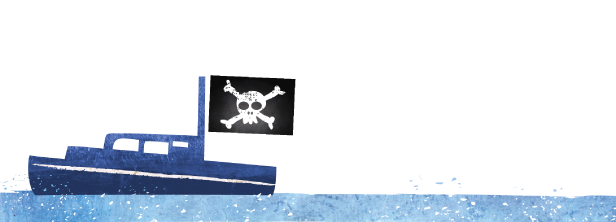Illegal, unreported, and unregulated

Piracy pays. Growing seafood demand, combined with fewer fish, poor traceability systems, and a vast ocean impossible to patrol adds up to big returns for those willing to catch fish illegally and funnel them into the legitimate supply chain.
Whether it consists of fishing in forbidden waters, catching protected species, using prohibited gear, or catching more than allowed, pirate fishing causes enormous economic and environmental damage. It skews the market for honest fishers, diverts revenue and food supply from coastal nations, depletes stocks for local fishers, and distorts catch statistics critical for setting regulations. Illegal, unreported, and unregulated fishing (IUU) depends on anonymity. New technologies that can expose pirate hideouts and plunder could bring an end to their pillaging in the near future.
Challenges
Low risk, high reward
Pirate fishing becomes more lucrative as global seafood demand grows and global fish stocks plummet.
Flags of convenience
In theory, the country to which a vessel is registered is responsible for monitoring that vessel’s activities; in practice, states that turn a blind eye to illegal activities provide flags of convenience in exchange for registration fees.
No VIN numbers for fishers
Until recently, fishing boats, unlike other maritime vessels, were exempt from having vessel identification numbers. Without these, re-flagging and renaming a ship to evade prosecution is easy. The International Maritime Organization recently removed that exemption, paving the way for member states and Regional Fisheries Management Organizations to mandate VIN numbers for fishing vessels.
Patchwork of regulatory bodies
No one regulatory body polices IUU. When IUU occurs in national waters, coastal states often lack enforcement capabilities. On the high seas, international management bodies can only police activities by vessels from countries that have signed on as parties to specific agreements.
At-sea processing
Huge floating fish-processing factory ships mean pirate fishers never have to go to port to “land” their catch before moving it into the supply chain.
Opportunities
Vessel monitoring systems
How a boat moves says a lot about what it fishes: the type of gear, the frequency of active fishing, the destination ports. Satellites put eyes on the water and provide new data to analyze vessel movement and potentially alert authorities to suspicious activities.
Traceability technology
New technology that labels and tracks fish at each point in the supply chain helps distributors identify IUU fish within their supply chains, while providing more confidence to retailers and consumers about the safety, origins, and nature of their seafood.
Local sourcing
A new wave of seafood distributors and retailers who take extra steps to source from local fishers with histories of responsible practices help to bring legal, sustainable catch to market.
The whole fish tale
Telling the story behind each seafood dish can help educate consumers about the larger human rights and environmental issues associated with IUU and increase demand (and therefore, price) for legal, safe, and sustainable fish.
Sources
i. Pew Environment Group, 2013. Illegal, Unreported, and Unregulated Fishing.
ii. Environmental Justice Foundation, 2014. Pirate Fishing.
iii. Greenpeace, 2013. Pirate Fishing.
iv. Cheeseman, G. 2013. Impacts of Worldwide Illegal Fishing. Triple Pundit.




